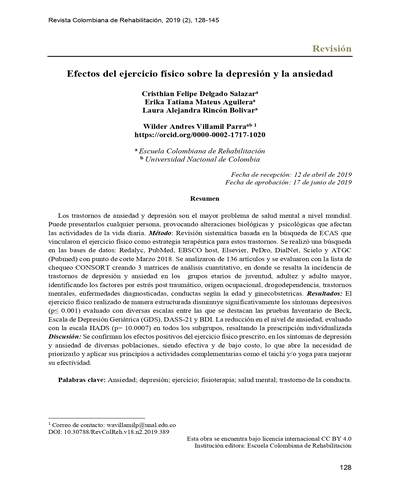Efectos del ejercicio físico sobre la depresión y la ansiedad
Contenido principal del artículo
Autores
Cristhian Felipe Delgado Salazarcristhiandelgado@ecr.edu.co
Erika Tatiana Mateus Aguliera
erikamateus@ecr.edu.co
Laura Alejandra Rincón Bolivar
laurarincon@ecr.edu.co
Wilder Andres Villamil Parra
wvillamil@ecr.edu.co
Resumen
Los trastornos de ansiedad y depresión son el mayor problema de salud mental a nivel mundial. Puede presentarlos cualquier persona, provocando alteraciones biológicas y psicológicas que afectan las actividades de la vida diaria. Método: Revisión sistemática basada en la búsqueda de ECAS que vincularon elejercicio físico como estrategia terapéutica para estos trastornos. Se realizó una búsqueda en las bases de datos: Redalyc, PubMed, EBSCO host, Elsevier, PeDro, DialNet, Scielo y ATGC (Pubmed) con punto de corte Marzo 2018.Se analizaron de 136 artículos y se evaluaron con la lista de chequeo CONSORT creando 3 mLos trastornos de ansiedad y depresión son el mayor problema de salud mental a nivel mundial. Puede presentarlos cualquier persona, provocando alteraciones biológicas y psicológicas que afectan las actividades de la vida diaria. Método: Revisión sistemática basada en la búsqueda de ECAS que vincularon elejercicio físico como estrategia terapéutica para estos trastornos. Se realizó una búsqueda en las bases de datos: Redalyc, PubMed, EBSCO host, Elsevier, PeDro, DialNet, Scielo y ATGC (Pubmed) con punto de corte Marzo 2018.Se analizaron de 136 artículos y se evaluaron con la lista de chequeo CONSORT creando 3 matrices de análisis cuantitativo, en donde se resalta la incidencia de trastornos de depresión y ansiedad en los grupos etarios de juventud, adultez y adulto mayor, identificando los factores por estrés post traumático, origen ocupacional, drogodependencia, trastornos mentales, enfermedades diagnosticadas, conductas según la edad y ginecobstetricas. Resultados:El ejercicio físico realizado de manera estructuradadisminuye significativamente los síntomas depresivos (p≤ 0.001) evaluado con diversas escalas entre las que se destacan las pruebas Inventario de Beck, Escala de Depresión Geriátrica (GDS), DASS-21 y BDI. La reducción en el nivel de ansiedad, evaluado con la escala HADS (p= 10.0007) en todos los subgrupos, resaltando la prescripción individualizada Discusión:Se confirmanlos efectos positivos del ejercicio físico prescrito, en los síntomas de depresión y ansiedad de diversas poblaciones, siendo efectiva y de bajo costo, lo que abre la necesidad de priorizarlo y aplicar sus principios a actividades complementarias como el taichi y/o yoga para mejorar su efectividad.
Palabras clave:
Detalles del artículo
Licencia
Aquellos autores/as que tengan publicaciones con esta revista, aceptan los términos siguientes:
- Los autores/as conservarán sus derechos de autor y garantizarán a la revista el derecho de primera publicación de su obra, el cuál estará simultáneamente sujeto a la Licencia de reconocimiento de Creative Commons que permite a terceros compartir la obra siempre que se indique su autor y su primera publicación esta revista.
- Los autores/as podrán adoptar otros acuerdos de licencia no exclusiva de distribución de la versión de la obra publicada (p. ej.: depositarla en un archivo telemático institucional o publicarla en un volumen monográfico) siempre que se indique la publicación inicial en esta revista.
- Se permite y recomienda a los autores/as difundir su obra a través de Internet (p. ej.: en archivos telemáticos institucionales o en su página web) antes y durante el proceso de envío, lo cual puede producir intercambios interesantes y aumentar las citas de la obra publicada. (Véase El efecto del acceso abierto).
Los autores que publican en la revista se acogen al código de licencia de Creative Commons Atribución 4.0 Internacional (CC BY 4.0)




Referencias
Aidar, F. J., Garrido, N. D., Silva, A. J., Reis, V. M., Marinho, D. A., & de Oliveira, R. J. (2013). Effects of aquatic exercise on depression and anxiety in ischemic stroke subjects. Health, 5(2), 222-228. Doi: 10.4236/health.2013.52030
Aidar, F. J., Oliveira, R. J. De, Matos, D. G. De, Chilibeck, P. D., Souza, R. F. de, Carneiro, A. L., & Reis, V. M. (2018). A randomized trial of the effects of an aquatic exercise program on depression, anxiety levels, and functional capacity in of people who suffered an ischemic stroke. The Journal of Sports Medicine and Physical Fitness, 58(7-8),1171-1177 Doi: 10.23736/S0022-4707.17.07284-X
Andersen, C., Rørth, M., Ejlertsen, B., Stage, M., Møller, T., Midtgaard, J., … Adamsen, L. (2013). The effects of a six-week supervised multimodal exercise intervention during chemotherapy on cancer-related fatigue. European Journal of Oncology Nursing, 17(3), 331-339. Doi: 10.1016/j.ejon.2012.09.003
Annesi, J. J., & Vaughn, L. L. (2011). Relationship of Exercise Volume with Change in Depression and Its Association with Self-Efficacy to Control Emotional Eating in Severely Obese Women. Advances in Preventive Medicine, 2011, 1-6. Doi: 10.4061/2011/514271
Arrébola, P. (2001). Ejercicio y hueso: Revisión bibliográfica. Revista Española de Enfermedades Metabólicas Óseas, 10(4), 119-131
Atlantis, E., Chow, C.-M., Kirby, A., & Singh, M. F. (2004). An effective exercise-based intervention for improving mental health and quality of life measures: a randomized controlled trial. Preventive Medicine, 39(2), 424-434. Doi: 10.1016/j.ypmed.2004.02.007
Aweto, H. A., Aiyegbusi, A. I., Ugonabo, A. J., & Adeyemo, T. A. (2016). Effects of Aerobic Exercise on the Pulmonary Functions, Respiratory Symptoms and Psychological Status of People Living With HIV. Journal of Research in Health Sciences, 16(1), 17-21. Recuperado de https://www.ncbi.nlm.nih.gov/pubmed/27061991
Baile, J. I. (2013). ¿Qué es la imagen corporal? Cuadernos del Marqués de San Adrián, 2, 53-70. Recuperado de https://dialnet.unirioja.es/servlet/articulo?codigo=2010565
Balchin, R., Linde, J., Blackhurst, D., Rauch, H. L., & Schönbächler, G. (2016). Sweating away depression? The impact of intensive exercise on depression. Journal of Affective Disorders, 200, 218-221. Doi:10.1016/j.jad.2016.04.030
Bonet, J., Parrado, E., & Capdevila, L. (2017). Efectos agudos del ejercicio físico sobre el estado de ánimo y la HRV. Revista Internacional de Medicina y Ciencias de la Actividad Física y del Deporte, 17(65). 85-100. Doi:10.15366/rimcafd2017.65.006
Branco, J. C., Jansen, K., Sobrinho, J. T., Carrapatoso, S., Spessato, B., Carvalho, J., … Silva, R. A. da. (2015). Physical benefits and reduction of depressive symptoms among the elderly: Results from the Portuguese «National Walking Program». Ciência & Saúde Coletiva, 20(3), 789-795. Doi: 10.1590/1413-81232015203.09882014
Castellón, A. D. (2012). Actualizaciones en depresión posparto. Revista Cubana de Obstetricia y Ginecología, 38(4), 576-586. Recuperado de http://scielo.sld.cu/scielo.php?script=sci_arttext&pid=S0138-600X2012000400016
Chan, W., Immink, M. A., & Hillier, S. (2012). Yoga and exercise for symptoms of depression and anxiety in people with poststroke disability: a randomized, controlled pilot trial. Alternative Therapies in Health and Medicine, 18(3), 34-43. Recuperado de https://www.ncbi.nlm.nih.gov/pubmed/22875560
Chen, H.-M., Tsai, C.-M., Wu, Y.-C., Lin, K.-C., & Lin, C.-C. (2015). Randomized controlled trial on the effectiveness of home-based walking exercise on anxiety, depression and cancer-related symptoms in patients with lung cancer. British Journal of Cancer, 112(3), 438-445. Doi: 10.1038/bjc.2014.612
Courneya, K. S., McKenzie, D. C., Gelmon, K., Mackey, J. R., Reid, R. D., Yasui, Y., … Segal, R. J. (2014). A Multicenter Randomized Trial of the Effects of Exercise Dose and Type on Psychosocial Distress in Breast Cancer Patients Undergoing Chemotherapy. Cancer Epidemiology Biomarkers & Prevention, 23(5), 857-864. Doi: 10.1158/1055-9965.EPI-13-1163
Cox, R. H., Thomas, T. R., Hinton, P. S., & Donahue, O. M. (2004). Effects of Acute 60 and 80% VO 2 max Bouts of Aerobic Exercise on State Anxiety of Women of Different Age Groups across Time. Research Quarterly for Exercise and Sport, 75(2), 165-175. Doi: 10.1080/02701367.2004.10609148
Daley, A. J., Blamey, R. V., Jolly, K., Roalfe, A. K., Turner, K. M., Coleman, S., … MacArthur, C. (2015). A pragmatic randomized controlled trial to evaluate the effectiveness of a facilitated exercise intervention as a treatment for postnatal depression: the PAM-PeRS trial. Psychological Medicine, 45(11), 2413-2425. Doi: 10.1017/S0033291715000409
Danielsson, L., Papoulias, I., Petersson, E.-L., Carlsson, J., & Waern, M. (2014). Exercise or basic body awareness therapy as add-on treatment for major depression: A controlled study. Journal of Affective Disorders, 168, 98-106. Doi: 10.1016/j.jad.2014.06.049
Dehghan-nayeri, N., & Adib-Hajbaghery, M. (2011). Effects of progressive relaxation on anxiety and quality of life in female students: A non-randomized controlled trial. Complementary Therapies in Medicine, 19(4), 194-200. Doi: 10.1016/j.ctim.2011.06.002
El-Shamy, F. (2013). Effect of Aerobic Exercise on Postmenopausal Women with Major Depression. British Journal of Applied Science & Technology, 3(2), 214-219. Doi: 10.9734/BJAST/2014/2667
Eng, J. J., & Reime, B. (2014). Exercise for depressive symptoms in stroke patients: a systematic review and meta-analysis. Clinical Rehabilitation, 28(8), 731-739. Doi: 10.1177/0269215514523631
Eriksen, H. R., Ihlebaek, C., Mikkelsen, A., Grønningsaeter, H., Sandal, G. M., & Ursin, H. (2002). Improving subjective health at the worksite: a randomized controlled trial of stress management training, physical exercise and an integrated health programme. Occupational Medicine (Oxford, England), 52(7), 383-391. Doi: 10.1093/occmed/52.7.383
Fetzner, M. G., & Asmundson, G. J. G. (2015). Aerobic Exercise Reduces Symptoms of Posttraumatic Stress Disorder: A Randomized Controlled Trial. Cognitive Behaviour Therapy, 44(4), 301-313. Doi: 10.1080/16506073.2014.916745
Firts, M. B., Frances, A., & Picus, H. A. (2003). Manual diagnóstico y estadístico de los trastornos mentales.
Garcia, M., & Martin, M. (2014). Adolescencia y Sexualidad: Resolviendo el Conflicto Natura-Cultura, [Trabajo fin de grado] Facultad de Educación de Palencia Universidad de Valladolid. Recuperado de https://uvadoc.uva.es/bitstream/handle/10324/6759/TFG-L650.pdf;jsessionid=87DBAEA76F630946C18A85EE8A8F4E3A?sequence=1
Haglund , M., Ang, A., Mooney, L., Gonzales, R., Chudzynski, J., Cooper, C. B., … Rawson, R. A. (2014). Predictors of depression outcomes among abstinent methamphetamine-dependent individuals exposed to an exercise intervention: Predictors of Depression Response to Exercise Treatment. The American Journal on Addictions, 24(3), 246-251. Doi: 10.1111/j.1521-0391.2014.12175.x
Harvath, T., A., & McKenzie, G. (2012). Depression in older adults. En: M. Boltz, E. Capezuti, T. Fulmer, D. Zwicker (Eds). Evidence-based geriatric nursing protocols for best practice. New York, USA: Springer Publishing Company
Instituto Colombiano de Bienestar Familiar [ICBF]. (2014). Impacto del conflicto armado en el estado Psicosocial de niños, niñas y adolescentes. Recuperado de https://repository.oim.org.co/handle/20.500.11788/541
Jaworska, N., Courtright, A. K., De Somma, E., MacQueen, G. M., & MacMaster, F. P. (2018). Aerobic exercise in depressed youth: A feasibility and clinical outcomes pilot. Early Intervention in Psychiatry, 13(1):128-132. doi: 10.1111/eip.12537. Doi: 10.1111/eip.12537
Jazaieri, H., Goldin, P. R., Werner, K., Ziv, M., & Gross, J. J. (2012). A Randomized Trial of MBSR Versus Aerobic Exercise for Social Anxiety Disorder: MBSR V. AE in SAD. Journal of Clinical Psychology, 68(7), 715-731. Doi: 10.1002/jclp.21863
Jindani, F., Turner, N., & Khalsa, S. B. S. (2015). A Yoga Intervention for Posttraumatic Stress: A Preliminary Randomized Control Trial. Evidence-based complementary and alternative medicine : eCAM. 351746. Doi: 10.1155/2015/351746.
Knubben, K., Reischies, F. M., Adli, M., Schlattmann, P., Bauer, M., Dimeo, F., & Ansley, L. (2006). A randomised, controlled study on the effects of a short-term endurance training programme in patients with major depression * Commentary. British Journal of Sports Medicine, 41(1), 29-33. Doi: 10.1136/bjsm.2006.030130
Lamego, M. K., Lattari, E., Sá Filho, A. S. de, Paes, F., Mascarenhas Jr., J., Maranhão Neto, G., … Machado, S. (2016). Aerobic exercise reduces anxiety symptoms and improves fitness in patients with panic disorder. Medical Express, 3(3). Doi: 10.5935/MedicalExpress.2016.03.06
LeBouthillier, D. M., & Asmundson, G. J. G. (2017). The efficacy of aerobic exercise and resistance training as transdiagnostic interventions for anxiety-related disorders and constructs: A randomized controlled trial. Journal of Anxiety Disorders, 52, 43-52. Doi: 10.1016/j.janxdis.2017.09.005
Macarena, L. G., & Silvio, D. M. (2016). Imagen corporal e insatisfacción con el propio cuerpo en Trastornos de Conducta Alimentaria en adolescentes. [Trabajo Fin de Grado]. Facultad de Humanidades y Ciencias de la Educación. Universidad de Jaén. Recuperado de: http://tauja.ujaen.es/bitstream/10953.1/3528/1/Lpez_Garca_Macarena_TFG_Psicologa.pdf
Marco, E., Duarte, E., Santos, J.-F., Aguirrezabal, A., Morales, A., Belmonte, R., … Escalada, F. (2010). Deterioro de la calidad de vida en cuidadores familiares de pacientes con discapacidad por ictus: una entidad a considerar. Revista de Calidad Asistencial, 25(6), 356-364. Doi: 10.1016/j.cali.2010.06.003
Midtgaard, J., Rørth, M., Stelter, R., Tveterås, A., Andersen, C., Quist, M., … Adamsen, L. (2005). The impact of a multidimensional exercise program on self-reported anxiety and depression in cancer patients undergoing chemotherapy: a phase II study. Palliative & Supportive Care, 3(3), 197-208. Recuperado de: https://www.ncbi.nlm.nih.gov/pubmed/16594459
Ministerio de Salud y Protección Social. (2017). Boletín de salud mental Depresión Subdirección de Enfermedades No Transmisibles. Recuperado de: https://www.minsalud.gov.co/sites/rid/Lists/BibliotecaDigital/RIDE/VS/PP/ENT/boletin-depresion-marzo-2017.pdf
Murray CJ Lopez. (1997). Global mortality, disability, and the contribution of risk factors: Global Burden of Disease Sudy. Lancet. 349, 1463-1442. Doi: 10.1016/S0140-6736(96)07495-8
Murri, M. B., Ekkekakis, P., Menchetti, M., Neviani, F., Trevisani, F., Tedeschi, S., … Amore, M. (2018). Physical exercise for late-life depression: Effects on symptom dimensions and time course. Journal of Affective Disorders, 230, 65-70. Doi: 10.1016/j.jad.2018.01.004
Musil, R., Seemüller, F., Meyer, S., Spellmann, I., Adli, M., Bauer, M., … Riedel, M. (2018). Subtypes of depression and their overlap in a naturalistic inpatient sample of major depressive disorder. International Journal of Methods in Psychiatric Research, 27(1), e1569. Doi: 10.1002/mpr.1569
Nia, F. R., Arazi, H., Rahimi, R., Kurd, K. P., & Hossaini, K. (2011). Effects of an eight-week circuit strength training program on the body images and anxiety in untrained college students. Medicina dello Sport, 63(3297), 308. Recuperado de: https://www.minervamedica.it/en/journals/medicina-dello-sport/article.php?cod=R26Y2011N03A0297
Oertel-Knöchel, V., Mehler, P., Thiel, C., Steinbrecher, K., Malchow, B., Tesky, V., … Hänsel, F. (2014). Effects of aerobic exercise on cognitive performance and individual psychopathology in depressive and schizophrenia patients. European Archives of Psychiatry and Clinical Neuroscience, 264(7), 589-604. Doi: 10.1007/s00406-014-0485-9
Organización Mundial de la Salud [OMS]. (2013). Plan de acción sobre salud mental 2013-2020. Recuperado de: https://www.who.int/mental_health/publications/action_plan/es/
Organización Mundial de la Salud [OMS]. (2017). Campañas Mundiales de la OMS: Aspectos esenciales de la campaña. Recuperado de: https://www.who.int/campaigns/world-health-day/2017/campaign-essentials/es/
Paolucci, E. M., Loukov, D., Bowdish, D. M. E., & Heisz, J. J. (2018). Exercise reduces depression and inflammation but intensity matters. Biological Psychology, 133, 79-84. Doi: 10.1016/j.biopsycho.2018.01.015
Penninx, B. W. J. H., Rejeski, W. J., Pandya, J., Miller, M. E., Di Bari, M., Applegate, W. B., & Pahor, M. (2002). Exercise and depressive symptoms: a comparison of aerobic and resistance exercise effects on emotional and physical function in older persons with high and low depressive symptomatology. The Journals of Gerontology. Series B, Psychological Sciences and Social Sciences, 57(2), P124-132. Doi: 10.1093/geronb/57.2.p124
Pomp, S., Fleig, L., Schwarzer, R., & Lippke, S. (2013). Effects of a self-regulation intervention on exercise are moderated by depressive symptoms: A quasi-experimental study. International Journal of Clinical and Health Psychology, 13(1), 1-8. Doi: 10.1016/S1697-2600(13)70001-2
Posada, J. (2013). La salud mental en Colombia. Revista Biomedica, 33(4).
Pourmousavi Khoshnab, L., & Nikseresht, A. (2016). Comparison of the Effect of Aerobic Exercise and Antidepressant Medications on Depression and Sexual Desire of Depressed Middle-Aged Women. International Journal of Women’s Health and Reproduction Sciences, 5(2), 119-122. Doi: 10.15296/ijwhr.2017.22
Quist, M., Adamsen, L., Rørth, M., Laursen, J. H., Christensen, K. B., & Langer, S. W. (2015). The Impact of a Multidimensional Exercise Intervention on Physical and Functional Capacity, Anxiety, and Depression in Patients With Advanced-Stage Lung Cancer Undergoing Chemotherapy. Integrative Cancer Therapies, 14(4), 341-349. Doi: 10.1177/1534735415572887
Rawson, R. A., Chudzynski, J., Gonzales, R., Mooney, L., Dickerson, D., Ang, A., … Cooper, C. B. (2015). The Impact of Exercise On Depression and Anxiety Symptoms Among Abstinent Methamphetamine-Dependent Individuals in A Residential Treatment Setting. Journal of Substance Abuse Treatment, 57, 36-40. Doi: 10.1016/j.jsat.2015.04.007
Smith, T. L., Masaki, K. H., Fong, K., Abbott, R. D., Ross, G. W., Petrovitch, H., … White, L. R. (2010). Effect of Walking Distance on 8-Year Incident Depressive Symptoms in Elderly Men with and without Chronic Disease: The Honolulu-Asia Aging Study: walking and 8-year incident depressive symptoms. Journal of the American Geriatrics Society, 58(8), 1447-1452. Doi: 10.1111/j.1532-5415.2010.02981.x
Smits, J. A. J., Berry, A. C., Rosenfield, D., Powers, M. B., Behar, E., & Otto, M. W. (2008). Reducing anxiety sensitivity with exercise. Depression and Anxiety, 25(8), 689-699. Doi: 10.1002/da.20411
Suh, M. R., Jung, H. H., Kim, S. B., Park, J. S., & Yang, W. S. (2002). Effects of regular exercise on anxiety, depression, and quality of life in maintenance hemodialysis patients. Renal Failure, 24(3), 337-345. Doi: 10.1081/jdi-120005367
Teruel, Y. C., Ruano, M. G., & Moles, T. V. (2012). Efecto del ejercicio físico en la enfermedad mental severa [Tesis de Grado]. Facultad de Fisioterapia. Escuela Colombiana de Rehabilitación. Recuperado de: https://repositorio.ecr.edu.co/bitstream/001/314/1/Delgado%20Cristhian%2C%20Mateus%20Erika%2C%20Rinc%C3%B3n%20Laura.pdf
Vancampfort, D., De Hert, M., Knapen, J., Maurissen, K., Raepsaet, J., Deckx, S., … Probst, M. (2011). Effects of progressive muscle relaxation on state anxiety and subjective well-being in people with schizophrenia: a randomized controlled trial. Clinical Rehabilitation, 25(6), 567-575. Doi: 10.1177/0269215510395633
Vaquero, R., Vaquero, C., Alacid, F., Muyo, J., López, P. and Miñarro, P. (2013). Imagen corporal; revisión bibliográfica. Nutrición Hospitalaria, (1), 27–35. Doi: 10.3305/nh.2013.28.1.6016
Vernaza, P., & Alvarez, G. (2011). Producción científica latinoamericana de fisioterapia / kinesiología. Aquichan, 11 (1), 94-107. Recuperado de: http://aquichan.unisabana.edu.co/index.php/aquichan/article/view/1820/2387
Villamil, W. (2018). Fisioterapia en cuidados intensivos, más allá del manejo respiratorio. Revista Colombiana de Rehabilitación, 17(1), 3-5. . Doi: 10.30788/RevColReh.v17.n1.2018.313
Villamil, W. (2018). Métodos de medición de la capacidad aeróbica y la fuerza muscular en pacientes con enfermedad pulmonar obstructiva crónica en un ambiente intrahospitalario. Movimiento Científico, 11(2), 55-62. Doi: 10.33881/2011-7191.mct.11202
Villamil, W., & Hernandez Edgar. (2018). Nivel de actividad física de pacientes con falla renal pertenecientes a un Programa de Diálisis Peritoneal. Revista de Nefrología Dialisis y Trasplantel, 38(1), 28-34. Recuperado de: https://www.revistarenal.org.ar/index.php/rndt/article/view/295
Wang, C., Schmid, C. H., Fielding, R. A., Harvey, W. F., Reid, K. F., Price, L. L., … McAlindon, T. (2018). Effect of tai chi versus aerobic exercise for fibromyalgia: comparative effectiveness randomized controlled trial. BMJ, k851. Doi: 10.1136/bmj.k851
Yang, C.-L., & Chen, C.-H. (2018). Effectiveness of aerobic gymnastic exercise on stress, fatigue, and sleep quality during postpartum: A pilot randomized controlled trial. International Journal of Nursing Studies, 77, 1-7. Doi: 10.1016/j.ijnurstu.2017.09.009
Yang, J.-E., Lee, T.-Y., & Kim, J.-K. (2017). The effect of a VR exercise program on falls and depression in the elderly with mild depression in the local community. Journal of Physical Therapy Science, 29(12), 2157-2159. Doi: 10.1589/jpts.29.2157


 PDF
PDF










